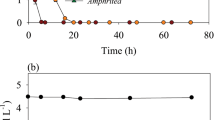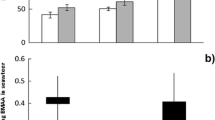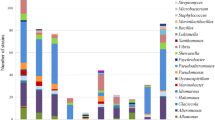Abstract
We have investigated the effects of seawater acidification on the activities of leucine aminopeptidase (LAPase), β-glucosidase (BGase), phosphatase (P-ase), α-glucosidase (AGase), and lipase (L-ase), which are important promoters of degradation of marine organic matter, including proteins, carbohydrates, organic phosphorus compounds, and lipids. Seawater samples were collected from a eutrophic coastal area, from Tokyo Bay, and from oligotrophic pelagic waters outside the Kuroshio Current. Enzyme activities were measured using fluorogenic substrates added to the seawater samples, which were acidified from pH 8.2 to 5.6 by a chemical buffer. Spontaneous hydrolysis of the substrates was shown to be negligible in heat-inactivated control samples, thus validating our results. LAPase was the most sensitive to acidification; enzyme activity rapidly decreased from pH 8.2 to 7.8, corresponding to a realistic scenario of ocean acidification. L-ase activity also decreased with acidification. Activities of P-ase and BGase were relatively constant across the pH levels examined, suggesting that their activity is not appreciably influenced by acidification. The effect of acidification on P-ase activities differed between the coastal and semipelagic samples, and this was likely due to freshwater influence at the nearshore station. Because of the low activity of AGase in the sample, the effect of acidification on this enzyme could not be examined. The effects of acidification on enzyme activity appear to vary depending on enzyme type and location, but we conclude that acidification will cause changes in the cycling of organic matter in marine ecosystems, in particular to proteinous and lipid substances.
Similar content being viewed by others
References
Ammerman, J. W. and F. Azam (1985): Bacterial 5′-nucleotidase in aquatic ecosystems: a novel mechanism of phosphorus regeneration. Science, 227, 1338–1340.
Arnosti, C. (2003): Microbial extracellular enzymes and their role in dissolved organic matter cycling. p. 315–342. In Aquatic Ecosystems: Interactivity of Dissolved Organic Matter, ed. by S. E. G. Findlay and R. L. Sinsabaugh, Academic Press, London.
Azam, F. and R. A. Long (2001): Sea snow microcosms. Nature, 414, 495–498.
Caldeira, K. and M. E. Wickett (2003): Anthropogenic carbon and ocean pH. Nature, 425, 365.
Caldeira, K. and M. E. Wickett (2005): Ocean model predictions of chemistry changes from carbon dioxide emissions to the atmosphere and ocean. J. Geophys. Res., 110, C09S04, doi:10.1029/JC002671.
Chen, B., Y. Song, M. Nishio, S. Someya and M. Akai (2005): Modeling near — field dispersion from direct injection of carbon dioxide into the ocean. J. Geophys. Res., 110, C09S15, doi:1029/2004JC002567.
Christian, J. R. and D. M. Karl (1995): Bacterial ectoenzymes in marine waters: Activity ratios and temperature responses in three oceanographic provinces. Limnol. Oceanogr., 40, 1042–1049.
Chróst, R. J. and W. Siuda (2002): Ecology of microbial enzymes in lake ecosystems. p. 35–72. In Enzymes in the Environment: Activity, Ecology, and Applications, ed. by R. G. Burns and R. P. Dick, Marcel Dekker, New York.
Coffin, R. B., M. T. Montgomery, T. J. Boyd and S. M. Masutani (2004): Influence of ocean CO2 sequestration on bacterial production. Energy, 29, 1511–1520.
Doney, S. C., V. J. Fabry, R. A. Feely and J. A. Kleypas (2009): Ocean acidification: The other CO2 problem. Annu. Rev. Mar. Sci., 1, 169–192, doi:10.1146/annurev.marine.010908.163834.
Dyhrman, S. T. and K. C. Ruttenberg (2006): Presence and regulation of alkaline phosphatase activity in eukaryotic phytoplankton from the coastal ocean: Implications for dissolved organic phosphorus remineralization. Limnol. Oceanogr., 51, 1381–1390.
El-Shahed, A. M., H. Ibrahim and M. Abd-Elnaeim (2006): Isolation and characterization of phosphatase enzyme from the freshwater macroalga Cladophora glomerata Kützing (chlorophyta). Pakistan J. Biol. Sci., 9, 2456–2461.
Engel, A., K. G. Schulz, U. Riebesell, R. Bellerby, B. Delille and M. Schartau (2008): Effects of CO2 on particle size distribution and phytoplankton abundance during a mesocosm bloom experiment (PeECE II). Biogeosciences, 5, 509–521.
Fukuda, R., Y. Sohrin, N. Saotome, H. Fukuda, T. Nagata and I. Koike (2000): East-west gradient in ectoenzymes activities in the subarctic Pacific: Possible regulation by zinc. Limnol. Oceanogr., 45, 930–939.
Gambin, F., G. Bogé and D. Jamet (1999): Alkaline phosphatase in a littoral Mediterranean marine ecosystem: Role of the main plankton size classes. Mar. Environ. Res., 47, 441–456.
Grossart, H.-P., M. Allgaier, U. Passow and U. Riebesell (2006): Testing the effect of CO2 concentration on the dynamics of marine heterotrophic bacterioplankton. Limnol. Oceanogr., 51, 1–11.
Herzog, H. J. (2001): What future for carbon capture and sequestration? Environ. Sci. Tech., 35, 148A–153A.
Hoffert, M. I., K. Caldeira, G. Benford, D. R. Criswell, C. Green, H. Herzog, A. K. Jain, H. S. Kheshgi, K. S. Lackner, J. S. Lewis, H. D. Lightfoot, W. Manheimer, J. C. Mankins, M. E. Mauel, L. J. Perkins, M. E. Schlesinger, T. Volk and T. M. L. Wigley (2002): Advanced technology paths to global climate stability: Energy for a greenhouse planet. Science, 298, 981–987.
Hollibaugh, J. T. and F. Azam (1983): Microbial degradation of dissolved proteins in seawater. Limnol. Oceanogr., 28, 1104–1116.
Hoppe, H.-G. (1983): Significance of exoenzymatic activities in the ecology of brackish water: measurements by means of methylumbelliferyl-substrates Mar. Ecol. Prog. Ser., 11, 299–308.
Hoppe, H.-G. (2003): Phosphatase activity in the sea. Hydrobiologia, 493, 187–200.
Hoppe, H.-G., H. C. Giesenhagen and K. Gocke (1998): Changing patterns of bacterial substrate decomposition in a eutrophication gradient. Aquat. Microb. Ecol., 15, 1–13.
Hoppe, H.-G., C. Arnosti and G. F. Herndl (2002): Ecological significance of bacterial enzymes in the marine environment. p. 73–107. In Enzymes in the Environment: Activity, Ecology, and Applications, ed. by R. G. Burns and R. P. Dick, Marcel Dekker, New York.
Huesemann, M. H., A. D. Skillman and E. A. Crecelius (2002): The inhibition of marine nitrification by ocean disposal of carbon dioxide. Mar. Pollut. Bull., 44, 142–148.
IMO (International Maritime Organization) (2008): London Protocol: Special Guidelines for Assessment of Carbon Dioxide Streams for Disposal into Sub-Seabed Geological Formations. 14 pp. (available at http://www.imo.org/includes/blastDataOnly.asp/data_id%3D25527/9-CO2SequestrationEnglish.pdf).
IPCC (Intergovernmental Panel on Climate Change) (2005): IPCC Special Report on Carbon Dioxide Capture and Storage. Prepared by Working Group III of the Intergovernmental Panel on Climate Change, ed. by B. Metz, O. Davidson, H. C. de Coninck, M. Loos and L. A. Meyer, Cambridge University Press, Cambridge and New York, 442 pp.
Ishimatsu, A., T. Kikkawa, M. Hayashi, K.-S. Lee and J. Kita (2004): Effects of CO2 on marine fish: larvae and adults. J. Oceanogr, 60, 731–741.
Karner, M., D. Fuks and G. J. Herndl (1992): Bacterial activity along a trophic gradient. Microb. Ecol., 24, 243–257.
Kleypas, J. A., R. A. Feely, V. J. Fabry, C. Langdon, C. L. Sabine and L. L. Robbins (2006): Impacts of Ocean Acidification on Coral Reefs and Other Marine Calcifiers: A Guide for Future Research. Report of a workshop sponsored by NSF, NOAA, and USGS, 88 pp. (available at http://www.isse.ucar.edu/florida/report/Ocean_acidification_res_guide.pdf).
Koike, I. and T. Nagata (1997): High potential activity of extracellular alkaline phosphatase in deep waters of the central Pacific. Deep-Sea Res. II, 44, 2283–2294.
Kurihara, H. (2008): Effects of CO2-driven ocean acidification on the early developmental stages of invertebrates. Mar. Ecol. Prog. Ser., 373, 275–284.
Li, H., M. J. W. Veldhuis and A. F. Post (1998): Alkaline phosphatase activities among planktonic communities in the northern Red Sea. Mar. Ecol. Prog. Ser., 173, 107–115.
Marchetti, C. (1977): On geoengineering and the CO2 problem. Clim. Change, 1, 59–68.
Mayor, D. J., C. Matthews, K. Cook, A. F. Zuur and S. Hay (2007): CO2-induced acidification affects hatching success in Calanus finmarchicus. Mar. Ecol. Prog. Ser., 350, 91–97.
Misic, C., M. Castellano, M. Fabiano, N. Ruggieri, V. Saggiomo and P. Povero (2006): Ectoenzymatic activity in surface waters: A transect from the Mediterranean Sea across the Indian Ocean to Australia. Deep-Sea Res. I, 53, 1517–1532.
Orr, J. C. (2004): Modelling of ocean storage of CO2-The GOSAC study, Report PH4/37, International Energy Agency, Greenhouse Gas R&D Programme, Cheltenham, U.K., 96 pp.
Orr, J. C., V. J. Fabry, O. Aumont, L. Bopp, S. C. Doney, R. A. Feely, A. Gnanadesikan, N. Gruber, A. Ishida, F. Joos, R. M. Key, K. Lindsay, E. Maier-Reimer, R. Matear, P. Monfray, A. Mouchet, R. G. Najjar, G.-K. Plattner, K. B. Rodgers, C. L. Sabine, J. L. Sarmiento, R. Schlitzer, R. D. Slater, I. T. Totterdell, M.-F. Weirig, Y. Yamanaka and A. Yool (2005): Anthropogenic ocean acidification over the twenty-first century and its impact on calcifying organisms. Nature, 437, 681–686.
Patel, A. B., K. Fukami and T. Nishijima (2000): Regulation of seasonal variability of aminopeptidase activities in surface and bottom waters of Uranouchi Inlet, Japan. Aquat. Microb. Ecol., 21, 139–149.
Revilla, M., J. Alexander and P. M. Glibert (2005): Urea analysis in coastal waters: comparison of enzymatic and direct methods. Limnol. Oceanogr.: Methods, 3, 290–299.
Riemann, L., G. F. Steward and F. Azam (2000): Dynamics of bacterial community composition and activity during a mesocosm diatom bloom. Appl. Environ. Microbiol., 66, 578–587.
Royal Society (2005): Ocean acidification due to increasing atmospheric carbon dioxide. Policy document 12/05. The Clyvedon Press, Cardiff, 57 pp. (available at http://royalsociety.org/displaypagedoc.asp?id=13539).
Sedlacek, L., D. Thistle, K. R. Carman, J. W. Fleeger and J. P. Barry (2009): Effects of carbon dioxide on deep-sea harpacticoids revisited. Deep-Sea Res. I, 56, 1018–1025.
Shitashima, K. (1997): CO2 supply from deep-sea hydrothermal systems. Waste Managemefnt, 17, 385–390.
Smith, D. C., M. Simon, A. L. Alldredge and F. Azam (1992): Intense hydrolytic enzyme activity on marine aggregates and implications for rapid particle dissolution. Nature, 359, 139–142.
Smith, W. H. F. and D. T. Sandwell (1997): Global sea floor topography from satellite altimetry and ship depth soundings. Science, 277, 1956–1962.
Takeuchi, K., Y. Fujioka, Y. Kawasaki and Y. Shirayama (1997): Impacts of high concentration of CO2 on marine organisms; a modification of CO2 ocean sequestration. Energy Convers. Manage., 38, S337–S341.
Tanaka, T., T. F. Thingstad, T. Løvdal, H.-P. Grossart, A. Larsen, K. G. Schulz and U. Riebesell (2008): Availability of phosphate for phytoplankton and bacteria and of labile organic carbon for bacteria at different pCO2 levels in a mesocosm study. Biogeosciences, 5, 669–678.
Weiss, M. S., U. Abele, J. Weckesser, W. Welte, E. Schiltz and G. E. Schulz (1991): Molecular architecture and electrostatic properties of a bacterial porin. Science, 254, 1627–1630.
Whitton, B. A., A. M. Al-Shehri, N. T. W. Ellwood and B. L. Turner (2004): Ecological aspects of phosphatase activity in Cyanobacteria, Eukaryotic algae and Bryophytes. p. 205–241. In Organic Phosphorus in the Environment, ed. by B. L. Turner, E. Frossard and D. S. Baldwin, CABI Publishing, Wallingford.
Wickett, M. E., K. Caldeira and P. B. Duffy (2003): Effect of horizontal grid resolution on simulations of oceanic CFC-11 uptake and direct injection of anthropogenic CO2. J. Geophys. Res., 108(C6), 3189, doi:10.1029/2001JC001130.
Author information
Authors and Affiliations
Corresponding author
Rights and permissions
About this article
Cite this article
Yamada, N., Suzumura, M. Effects of seawater acidification on hydrolytic enzyme activities. J Oceanogr 66, 233–241 (2010). https://doi.org/10.1007/s10872-010-0021-0
Received:
Revised:
Accepted:
Published:
Issue Date:
DOI: https://doi.org/10.1007/s10872-010-0021-0




